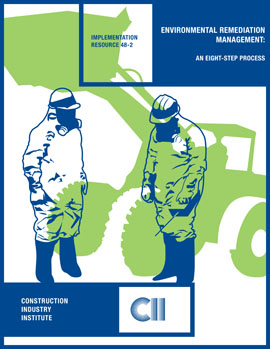
Environmental Remediation Management: An Eight-Step Process - Instructor's Guide
This module stresses the need for early and sustained planning in environmental remediation projects and outlines an eight-step process for proactively managing remediation projects to maximize success as defined by schedule and budget. It also emphasizes the importance of planning for possible site contamination in the front end of conventional construction projects. The presentation lecture is supplemented by inclusion of a fictional case study that requires participant interaction and discussion. The objective of the case study is to enhance participant understanding of the key aspects of remediation management and to provide an opportunity to implement portions of the remediation management process. CII Implementation Resource 48-2, Environmental Remediation: An Eight-Step Process, serves as the primary CII information source for the module.
- The Module Overview and Introduction provides an overview of the module, the key objectives, and introduces the importance of planning in remediation projects. The introduction also stresses the importance of anticipating site contamination during construction project planning and identifies the unique aspects of site remediation projects that differentiate them from conventional projects.
- Problem Identification covers the concepts presented in Step 1 (Problem Identification) of the “Eight-Step Process.” It emphasizes the need to act quickly and effectively when potential site contamination is identified.
- Exercise 1 of Case Study requires participants to formulate an initial assessment plan to respond to potential contamination at a fictional site.
- Planning and Evaluation covers the concepts presented in Step 2 (Preliminary Remediation Planning), Step 3 (Site Characterization/Risk Assessment), and Step 4 (Feasibility Study and Remedy Selection) of the “Eight-Step Process.” It emphasizes the ability of the owner to influence the outcome of the remediation project through early planning and proactive management and identifies activities critical to project scope definition and remedy selection.
- Exercise 2 of Case Study utilizes open discussion to reinforce participant recognition of the importance of site remediation planning which considers alternative outcomes, project scope definition, and technology screening to choosing the most cost-effective remedy.
- Project Implementation covers the concepts presented in Step 5 (Final Site Remediation Plan), Step 6 (Remedial Design Process), and Step 7 (Remedial Construction Process) of the “Eight-Step Process.” It emphasizes the need to accommodate unique remediation project requirements when choosing contractors, and provides guidance for implementing management and contracting strategies, budgeting, and scheduling for remediation projects.
- Exercise 3 of Case study requires participants to identify remediation project objectives, deliverables and risks from both the owner and contractor point-of-view and to choose management and contracting structures most appropriate to these objectives, deliverables and risks.
- Long-term Consequences covers the concepts presented in Step 8 (Post-Remedial Construction Activities) of the “Eight-Step Process.” The need to recognize, plan for and budget for possible long-term operation and monitoring is stressed.
- Summary reiterates the key issues and course objectives.



